Meet the Slate Colored Junco and Other Types of Juncos
Updated: Feb. 02, 2022
Learn to identify six different types of dark-eyed juncos, including the slate colored junco and Oregon junco, and find out where to spot them.
Types of Juncos and How to Identify Them
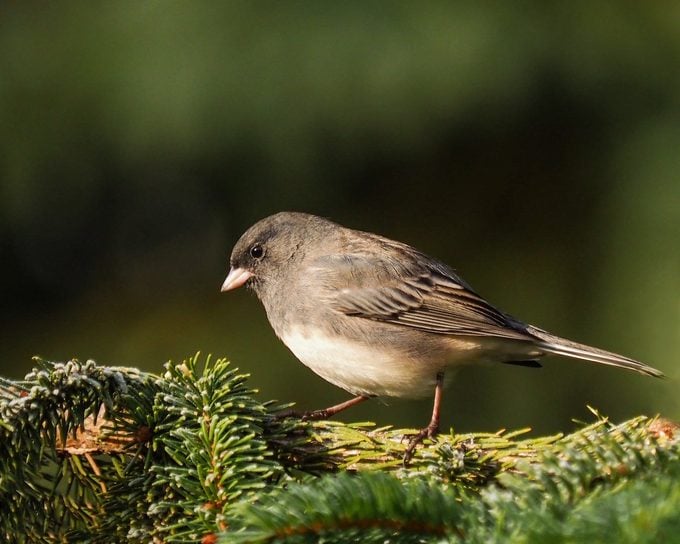
Dark eyed juncos wear subtle hues of gray, brown and white, with round little bodies and sweet expressions. They are often referred to as snowbirds because they appear to carry gray storm clouds on their backs and white snow on their bellies. But they also earn this nickname because of the cadence of their southerly migration—they fly into many areas just in time to usher in winter snows. Juncos show a remarkable amount of variation from place to place. Their regional color forms were previously classified as separate species. Now most have been combined under the name of dark eyed junco, but it’s easy to recognize the differences in plumage. Depending on where you live, you might expect to see multiple types of juncos, including the slate colored junco and Oregon junco.
Eastern vs. Western Junco Species

Depending on where you live, your juncos may look different. Those found in the eastern half of the U.S. are charcoal gray on top with white bellies and known as slate colored juncos. The most common variety in the west is called the Oregon junco. Other types of juncos, like white-winged and gray-headed, are less common with limited ranges. Always look for their signature field mark—a pretty pink bill.
Learn about western birds and their eastern counterparts.
All Types of Juncos Are in the Sparrow Family
Look for these dark-eyed beauties in mixed flocks with other sparrows and bluebirds. They fit in well with these birds because juncos are actually members of the sparrow family, despite their different color pattern. Where junco ranges overlap, you may find several types of juncos in one winter flock.
Slate Colored Junco
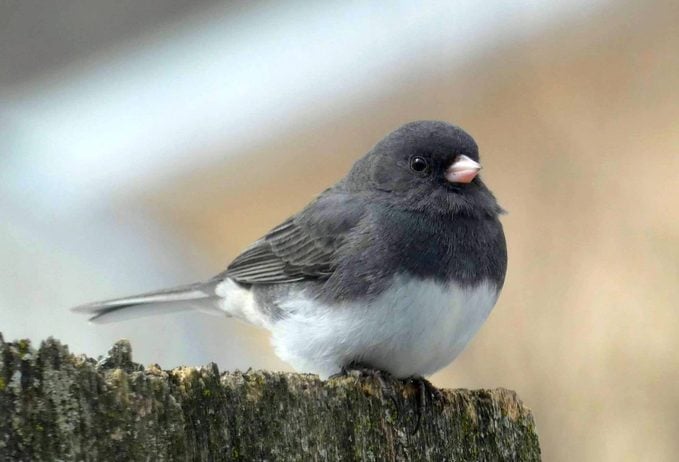
Of all the forms of dark eyed juncos, the the slate colored type has the widest range. Find slate colored juncos in summer across most of Alaska and Canada, south into the northeastern states and the Appalachians, and as far south as Georgia. In winter they are common from southern Canada to the Gulf states, mostly east of the Rockies but with a few scattered throughout the West.
Slate colored juncos are the least colorful of the juncos, with their basic gray and white, but they are still beautiful in their simplicity. They share some similarities with other types of juncos, such as their white outer tail feathers that are obvious when they fly. In addition, they almost always build their nests on the ground, usually in a spot well hidden under shrubs or overhanging branches. And, like other juncos, they form small flocks in winter, often joining with other birds, such as white-throated sparrows or American tree sparrows.
For their winter habitat, juncos favor partially open areas, including the edges of woods and suburban backyards. White proso millet, sunflower chips and other types of high-quality seeds lure them to feeders. They are most likely to use open-tray feeders close to the ground and often just forage on the ground underneath the feeders. Find out what foods juncos eat.
Oregon Junco

The Oregon junco is the most widespread type of junco in the West. They have a nesting range that stretches from southeastern Alaska through western Canada, to Idaho and Wyoming, and south throughout the West Coast states. Oregon juncos are found in summer in the high mountains and along the coast in Washington, Oregon and California. They readily adapt to nesting in parks and gardens, so they’re actually year-round backyard birds in many places.
Oregon juncos don’t all look the same. In some areas the males have black heads, while in other areas the heads are dark gray or blue-gray. The colors of the back and sides vary from dark brown to bright cinnamon to pale pinkish brown. All are more colorful than the slate colored juncos of the East.
Junco vs chickadee: Here’s how to tell the difference.
White Winged Junco
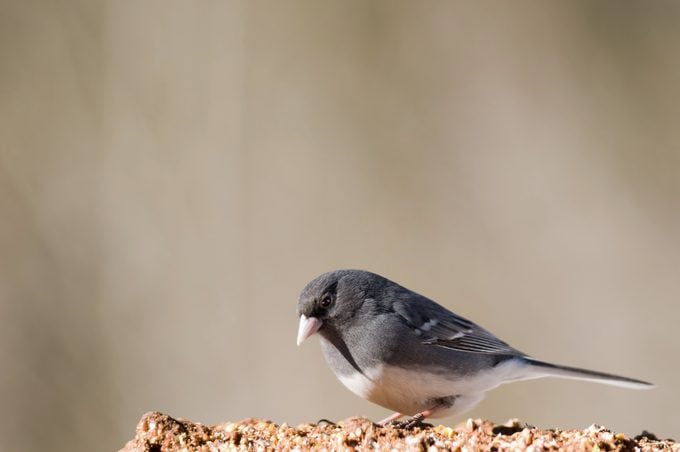
The Black Hills area of South Dakota makes up most of the summer range of the white winged junco. Despite its name, the bird has wings that are mostly gray with only two narrow white wing bars. Aside from those marks, it looks like a slightly larger, paler gray version of the slate colored junco.
Discover 12 winter bird myths and facts.
Pink Sided Junco
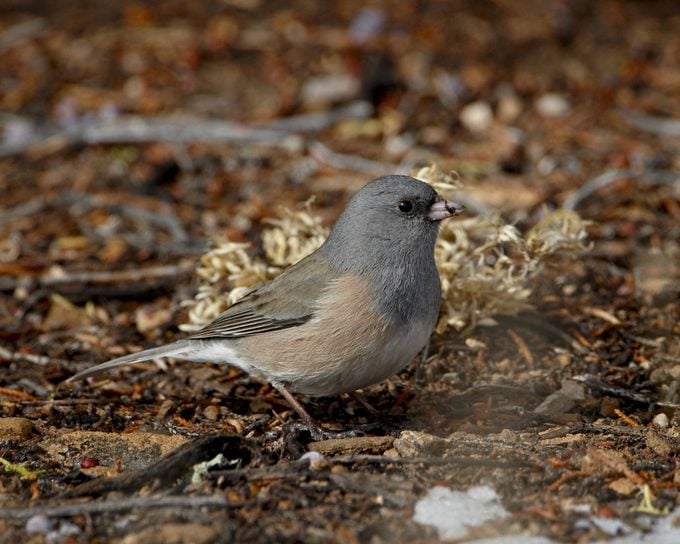
Just out to the west, in Wyoming and southern Montana, is the summer range of dark eyed juncos that are also large and pale, but with brown backs and pinkish buff sides. The birds are sometimes called pink sided juncos but are occasionally considered a type of Oregon junco. Both white winged and pink sided juncos spread south in winter, mainly along the east side of the Rockies.
Learn how to attract a chipping sparrow.
Gray Headed Junco
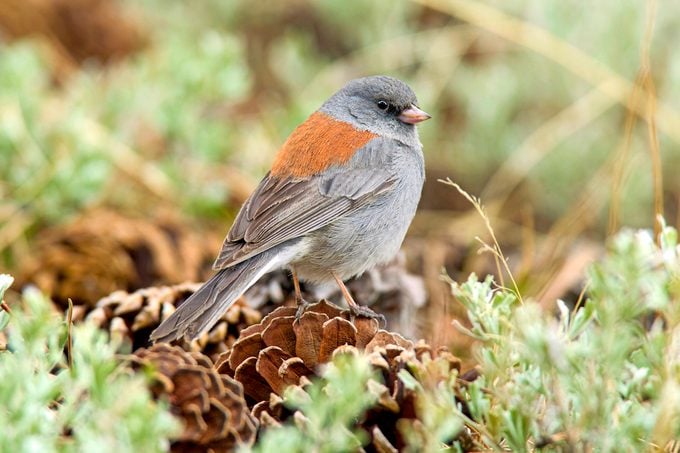
The mountains of Colorado, Utah and Nevada are the main summer range of the gray headed junco. This bird is mostly gray, including its head, back and wings, but the center of its back is a bright reddish brown. Like the other dark eyed juncos, its bill is pale pink.
Psst—here’s how to identify a song sparrow.
Red Backed Junco
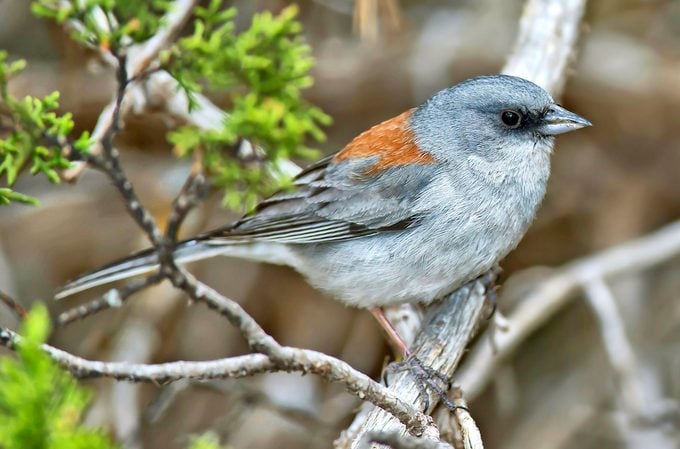
But just to the south, in the mountains of central Arizona and New Mexico, lives a bird that looks almost the same but with a bill at least half black. Called the red backed junco, it’s less migratory than most of its cousins, generally staying in the same mountain forests during all seasons.
At some places in the West, three or four types of dark eyed juncos may mix together in the same winter flocks. In the East, almost all the juncos are of the slate colored type, but the occasional Oregon junco wanders as far east as the Atlantic Coast. Wherever they go, whether they herald the coming of snow or just a mild change of seasons, these gentle, attractive birds are always welcome visitors.
Next, learn the difference between a western bluebird vs eastern bluebird.




















